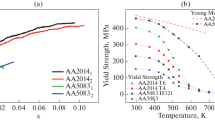Abstract
In the current trend toward thicker aluminium plates, a major concern is the generation of high internal stresses during quenching, which can cause distortions during machining and pose serious safety concerns. Although the material is stretched after quench, substantially reducing residual stresses, they are not fully suppressed. In addition, the cooling rate is not large enough at the core of such thick plates to prevent any precipitation. This has a great impact on the efficiency of ageing. In this work, residual stress distributions in a heat-treatable aluminium alloy AA7449 thick plate in the as-quenched state measured by neutron diffraction are presented. A comparison between single (311) diffraction peak and multiple peaks analysis using Pawley algorithm is shown. The variation of the stress free reference value through the plate thickness is discussed and measured stresses are compared with residual stresses predicted by a thermo-mechanical finite element model of quenching.
Access this chapter
Tax calculation will be finalised at checkout
Purchases are for personal use only
Preview
Unable to display preview. Download preview PDF.
Similar content being viewed by others
References
Drezet J.-M., et al., Jim Evans Honorary Symposium, Eds. B.-Q. Li, B.-G. Thomas, L. Zhang, F.-M. Doyle and A.-P. Campbell, TMS, 2010: p. 43–52.
Muammer, K., J. Culp, and A. Taylan, Journal of Materials Processing Technology, 2006. 174: p. 342–354.
Jeanmart, P. and J. Bouvaist, Materials Science and Technology, 1985. 1(10): p. 765–769.
Robinson, J.S., et al., Materials Characterization, 2012. 65: p. 73–85.
Godard, D., PhD Thesis Institut National Polytechnique de Lorraine (INPL) France. 1999.
Pawley, G.S., Journal of Applied Crystallography, 1981. 14: p. 357–361.
Carron D., et al., Revue de métallurgie, 2010. 107(10–11): p. 445–448.
Li, P., et al., Metallurgical and Materials Transactions B, 2007. 38(4): p. 505–515.
Tanner, D.A. and J.S. Robinson, Journal of Materials Processing Technology, 2004.153–154: p. 998–1004.
Author information
Authors and Affiliations
Editor information
Editors and Affiliations
Rights and permissions
Copyright information
© 2012 TMS (The Minerals, Metals & Materials Society)
About this paper
Cite this paper
Chobaut, N., Repper, J., Pirling, T., Carron, D., Drezet, JM. (2012). Residual Stress Analysis in AA7449 As-Quenched Thick Plates Using Neutrons and Fe Modelling. In: Weiland, H., Rollett, A.D., Cassada, W.A. (eds) ICAA13 Pittsburgh. Springer, Cham. https://doi.org/10.1007/978-3-319-48761-8_44
Download citation
DOI: https://doi.org/10.1007/978-3-319-48761-8_44
Publisher Name: Springer, Cham
Print ISBN: 978-3-319-48225-5
Online ISBN: 978-3-319-48761-8
eBook Packages: Chemistry and Materials ScienceChemistry and Material Science (R0)




